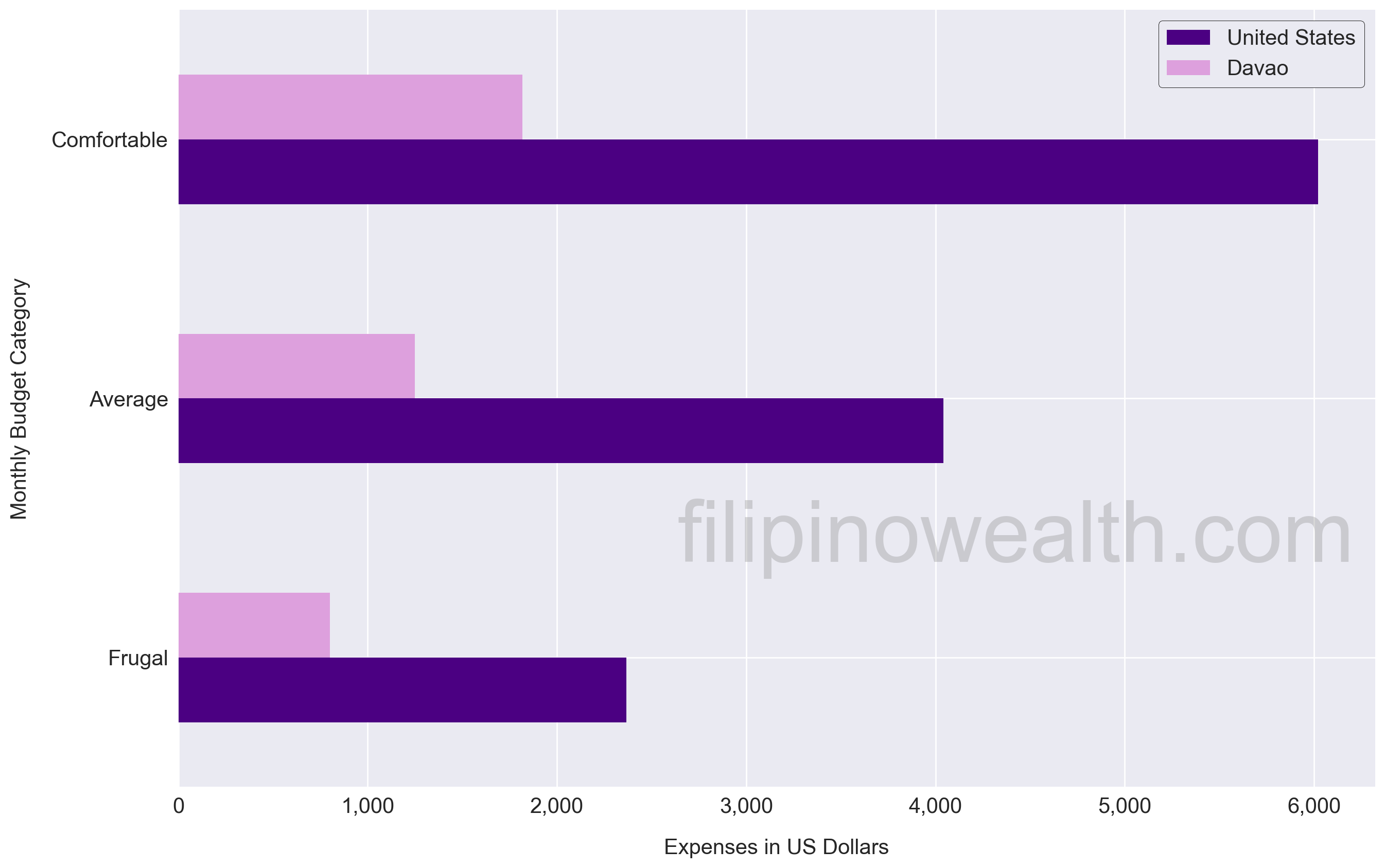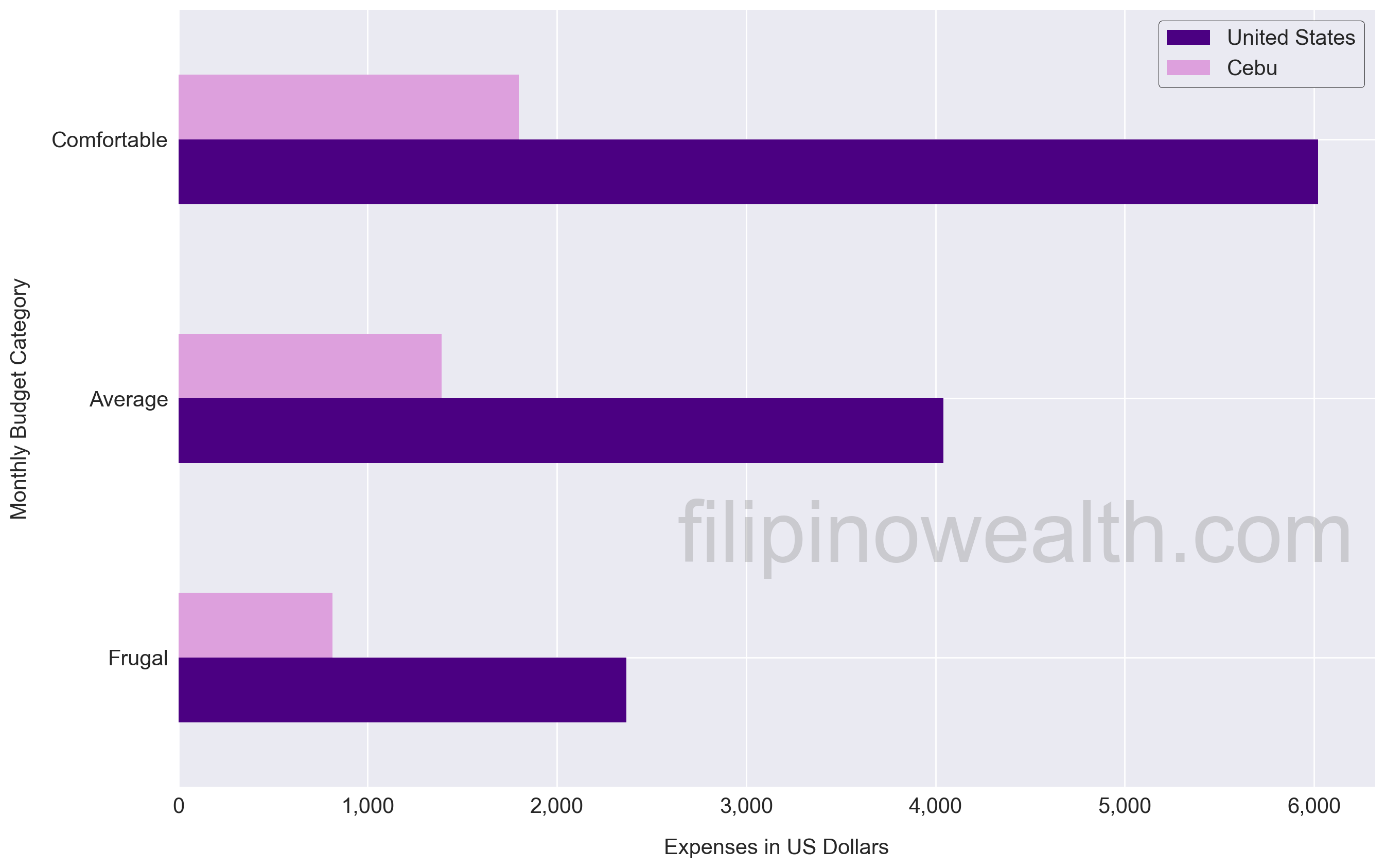Are you considering moving to the Philippines? Or maybe you’re considering a long vacation to the Pearl of the Orient Seas? Either way, this article should provide you with a reasonable idea of the cost of living in the Philippines compared to the Unites States !
Before we dive in, if you are planning on retiring in the Philippines from the US, you may want to check out this article which covers how much you would need to retire in the Philippines.
It’s no secret that the Philippines is one of the cheapest places to live in the world. Moreover, with its tropical climate, it’s also one of the most beautiful places to live in the world. However, it’s important to note that while pretty, the Philippines can be slightly more expensive in metropolitan areas such as Manila.
To factor in location effects, this article will explore the cost of living in major cities in the Philippines against the average cost of living in the United States. For simplicity, this breakdown will consider the typical cost of living for a single person.
Table of Contents
Cost of Living – How we estimated monthly expenses
For the calculation of monthly expenses, we developed an expense model of typical expenses for various cities in the Philippines. The model was based on data from Numbeo.com. Numbeo is a collection of user-submitted data containing numerical and other itemizable data about cities and countries, designed to enable crowdsourcing of expenses. To put it more simply, Numbeo is like the Wikipedia of expenses. Primary monthly expenses were broken down into following categories:
- Transportation – it was assumed that transportation would consist of fuel and car payments. This assumption was considered conservative as public transport should reduce expenses considerably;
- Housing – a single one bedroom apartment;
- Groceries were accounted for as a fraction of rent;
- Luxury items such as non-essential clothing items, electronics and impulse purchases;
- Utilities – water, refuse/garbage, electricity and internet costs;
- Restaurants – dining out; and
- Leisure activities – weekend activities and after work activities.
Okay this probably sounds like a lot, but it’ll all make sense in the next few graphs (I promise!). But before we get there, not everyone spends equally. For example, what if you’re someone that relies on a diet of ramen and intermittent fasting to save money? Or what if you’re someone that eats out every second day and always has the latest iPhone? To consider these hypothetical lifestyles, we have devised three tiers of lifestyle categories:
- Frugal;
- Average; and
- Comfortable.
Okay now that that’s covered, the next couple of sections describe the cost of living in major cities around the Philippines.
Cost of living in Manila vs the United states
With a population of more than 1.8 million people, Manila is one of the most densely populated cities in the world.
The cost of living in Manila is one of the highest in the Philippines (if not the highest).
There are several factors that contribute to this phenomenon. Firstly, the city’s geographical location is ideal for harbour trade. Second and third are its rich cultural heritage derived from its colonial past, as well as possessing a vibrant metropolitan environment and central business district.
A bar plot of expenses comparing the average cost of living in the United States against a similar budget in Manila is shown below.

From the data above, on a comfortable budget, you can expect to pay around 60% less than you would in the United States. Similarly, considering an average and frugal budget you can expect to pay 53% less and 60% less respectively by living in Manila compared to the United States.
Cost of living in Quezon City vs The United States
With a population of close to 3 million people, Quezon City is the most populous city in the Philippines.
The average cost of living in Quezon City is approximately 16% less expensive than Manila according to our expense model.
The economy of Quezon City thrives primarily around business and commerce, banking and finance, tourism and retail. Quezon City is also regarded as one of the wealthiest cities in the Philippines.
A bar plot of expenses comparing the average cost of living in the United States against a similar budget in Quezon City is shown below.

From the data above, on a comfortable budget, you can expect to pay around 69% less than you would in the United States. Similarly, considering an average and frugal budget you can expect to pay 61% less and 58% less respectively by living in Quezon City compared to the United States.
Cost of living in Davao vs The United States
Davao is a city in the south of the Philippines and is referred to as the King City of the South. With a population of close to 1.8 million people, Davao is the third most populous city in the Philippines.
The average cost of living in Davao is approximately 34% less expensive than Manila according to our expense model and is the cheapest city on our list of cities analysed.
Davao City has the largest local economy in the Southern Philippines. Agriculture remains the largest economic sector. It is the Southern island’s leading exporter of fruits such as mangoes, pomelos, bananas, coconut products, pineapples, etc.
A bar plot of expenses comparing the average cost of living in the Untied States against a similar budget in Davao is shown below.

From the data above, on a comfortable budget, you can expect to pay around 70% less than you would in the United States. Similarly, considering an average and frugal budget you can expect to pay 69% less and 66% less respectively by living in Davao compared to the United States.
Cost of living in Cebu vs The United States
Cebu is a city in the south of the Philippines and is referred to as the Queen City of the South. With a population of close to 1 million people, Cebu is the sixth most populous city in the Philippines.
The average cost of living in Cebu is approximately 26% less expensive than Manila according to our expense model and is therefore the 2nd cheapest city on our list of cities analysed.
Cebu is centrally located in the Philippines and therefore is easily accessible by air , land, and sea transportation – and has become a popular tourist gateway to Central and Southern Philippines.
A bar plot of expenses comparing the average cost of living in the United States against a similar budget in Cebu is shown below.

From the data above, on a comfortable budget, you can expect to pay around 70% less than you would in the United States. Similarly, considering an average and frugal budget you can expect to pay 66% less and 66% less respectively by living in Cebu compared to the United States.
frequently asked questions:
How much does it cost to live in the Philippines in US dollars?
Depending on which city you plan on living in, your average monthly expenses could range between $1200 (in Davao) to $2000 (in Manila).
Is Philippines expensive to live?
Living in the Philippines is very affordable and you can expect monthly expenses to be approximately 60-70% less than what your expenses would be in the United States. Davao was found to be the cheapest city to live in the Philippines with Manila as the most expensive – however, both cities are inexpensive compared to an average American lifestyle.
How much do I need to retire comfortably in the Philippines?
To retire in the Philippines you would need between $ 191,100 and $ 572,500 depending on your monthly expenses and safe withdrawal rate.
More Philippines Business Guides
- Cost of Living in the Philippines 2022
- Cost of living in the Philippines vs. The United States
- Cost of living in the Philippines vs. Australia
- Can I Live Comfortably in the Philippines
- Best Dollar Accounts in the Philippines
- Cost of living: Philippines vs. United States
- 15 Exclusive Ways How To Live Cheaper In The Philippines
- 15 Tips How To Live In The Philippines As A Foreigner
- 5 Best Places To Live Philippines 2022
- Best Business For Foreigners Philippines
- Best Place To Retire Philippines 2022
- Can A Canadian Own A Business Philippines
- Can A Foreigner Drive In The Philippines?
- Can A Foreigner Get A Loan In The Philippines?
- Can Foreigners Invest In Philippines Stock Market?
- Cheapest Cities To Live Philippines 2022
- Cheapest Places To Retire Philippines
- Cost Of Living In Quezon City For Expats
- Do You Want To Retire In Cebu Philippines?
- Examples Of Foreign Investment Philippines
- Expat Cost Of Living Davao City In 2022
- Expat Cost Of Living In Cebu Philippines
- Expat Living Outside Of Davao City
- Full Moving To The Philippines From The USA
- Health Insurance For Foreigners Philippines 2022
- Helpful Guide Living In Pasay City As A Foreigner
- Helpful Guide To Living In Olongapo City As An Expat
- How Can A Foreigner Invest In The Philippines
- How Can A Foreigner Work Philippines Legally?
- How Much Does It Cost To Live Comfortably Philippines 2022
- How Much Is The Minimum Cost Of Living In The Philippines
- How Much Money To Bring To The Philippines
- How Much To Live Like A King Philippines
- How To Find Cheap Flights To The Philippines
- How To Invest In The Philippines From USA
- How To Make Friends In The Philippines
- How To Make Money Philippines As A Foreigner
- How To Open A Bank Account Philippines For Foreigners
- How To Open A Business Philippines From Australia
- How To Open A Business Philippines From UK
- How To Rent A Condo Philippines As An Expat
- How To Send Money From Abroad Philippines
- How To Stay In The Philippines Permanently
- Is It Better To Live In Thailand Or Philippines
- Is It Safe In The Philippines For Foreigners?
- Is Tagalog Easy Or Hard To Learn For Beginners
- Life As An Expat Living In Davao City
- Live & Retire In Puerto Princesa Palawan
- Living In Angeles City Philippines As An Expat
- Living In Bacolod Philippines As An Expat
- Living In Butuan City As An Expat
- Living In Cagayan De Oro Philippines For Expats
- Living In General Santos City Philippines As A Foreigner
- Living In Lapu Lapu City As A Foreigners
- Living In Manila Philippines As A Foreigners
- Living In Manila Pros And Cons
- Living In Palawan Philippines As A Foreigner
- Living In Pasig City Philippines As A Foreigner
- Living In The Philippines On $1000 Or More
- Living Las Piñas Philippines For Expats
- Moving Or Retiring To The Philippines From UK
- Moving To Leyte Philippines For Foreigners
- Philippines Living Costs For First Timers
- Retirement & Living In Makati For Foreigners
- Should I Bring Cash To The Philippines
- Should I Retire In The Philippines?
- Starting A Business Philippines As A Foreigner
- Ultimate Guide To Dating Philippines 2022
- What Is Considered Rich In The Philippines
- What Is It Like To Live In Manila?
- What Is Life Like In The Philippines 2022
- What Its Like Living In Cebu As A Foreigner
- What To Take To Philippines Checklist
- What You Can Buy Philippines On A Budget
- Which Is Cheaper – Thailand vs Philippines
Nice one thanks for sharing this quality information
Comments are closed.